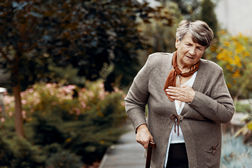Dyspnea
 Dyspnea or breathlessness is a subjective symptom. Patients report they have difficulty breathing. It is essential to know if this breathless feeling is associated with severe anxiety or a physical cause (Fardy, 2016). According to Albert (2017), dyspnea can be caused by the following:
Dyspnea or breathlessness is a subjective symptom. Patients report they have difficulty breathing. It is essential to know if this breathless feeling is associated with severe anxiety or a physical cause (Fardy, 2016). According to Albert (2017), dyspnea can be caused by the following:
- Aspiration pneumonitis or pneumonia
- Airway hyperreactivity
- Pulmonary edema
- Pleural effusion
- Deconditioning.
|
The estimated prevalence of breathlessness in advanced disease |
Cancer |
10–70% |
AIDS |
11–62% |
Heart disease |
60–88% |
Chronic obstructive pulmonary disease |
90–95% |
Chronic kidney disease |
11–62% |
These are known physical causes of breathlessness in palliative care patients:
- Heart failure
- Pulmonary embolus
- Infection
- Arrhythmia
- Anemia
- Ascites
A useful tool for assessing dyspnea through observation is the Respiratory Distress Observation Scale (RDOS) https://www.ncbi.nlm.nih.gov/pmc/articles/PMC4429859/ It contains eight variables:
| Heart Rate: |
Respiratory Rate |
| Restlessness |
Abdominal Muscle Use |
| Accessory muscle use |
Grunting |
| Nasal Flaring |
Look of fear |
Opioids are considered the medication of choice for the treatment of breathlessness (Hui, D. 2020). Oxygen therapy is only recommended for hypoxic patients. No evidence supports the improvement of breathlessness using oxygen if the O2 levels are in a normal range (Albert, 2017; Fardy, 2016).
Non-pharmacological Interventions to Manage Breathlessness (Powell, 2014) |
| Intervention |
Aim |
Evidence |
Pulmonary rehabilitation and exercise, e.g., belly breathing, pursed lip breathing, and diaphragmatic breathing, arm-raises, Tai Chi, etc. |
Desensitizes patient, reduces deconditioning, reduces ventilator demand and slows respiration |
Strong for COPD |
| Neuromuscular electrical stimulation (NMES) |
NMES can improve muscular conditioning with passive exercise training of smaller muscle mass, thereby reducing ventilatory stress |
Strong for COPD |
| Forward positioning |
Improves efficacy of accessory muscles |
Patients with COPD develop this pattern naturally |
| Walking aids |
Allow forward leaning to decrease work of breathing and increases patient confidence during ambulation |
Moderate |
| Pursed-lip breathing |
Promotes improved gas exchangeand, reduced workload |
Moderate - literature varies |
| Facial cooling, fans, etc |
May interurpt upper airway to respiratory center signaling |
Short-term strong
Long-term moderate |
| Acupuncture |
Stimulates endogenous beta-endorphin release |
Limited evidence |
| Anxiety and depression reduction with Cognitive behavioral therapy (CBT) |
Promotes mastery of situation, emotions, behaviors and symptoms to improve mental & physical conditioning |
Limited evidence but promising for advanced COPD |
| Multi-professional breathlessness clinic |
Improves patient self-efficacy with collaborative pharacologic and non-pharmacologic strategies |
RCT preliminary results seem positive |
| Source: Powell, B. (2014). Managing breathlessness in advanced disease. Clin Med (Lond). 14(3), 308–311. |
Instant Feedback:
Opioids are considered the medication of choice for the treatment of breathlessness..
References
Albert, R.H. (2017). End-of-life care: Managing common symptoms. American Family Physician. 95(6), 356-361.
Campbell, M. L., Templin, T. & Walch, J. (2010). A Respiratory Distress Observation Scale for Patients Unable To Self-Report Dyspnea. Journal of Palliative Medicine. 13(3), 285-290.
Del Fabbro, E., Dalal, S. & Bruera, E. (2006). Symptom control in palliative care—part iii: Dyspnea and delirium. Journal of Palliative Medicine. 9(2).
Fardy H. J. (2016). Oxygen therapy in palliative care. NPJ primary care respiratory medicine, 26, 15073.
Hui, D., & Bruera, E. (2020). Use of short-acting opioids in the management of breathlessness: an evidence-based review. Current opinion in supportive and palliative care, 14(3), 167–176. https://doi.org/10.1097/SPC.0000000000000509
Powell, B. (2014). Managing breathlessness in advanced disease. Clin Med (Lond). 14(3), 308–311.
 Dyspnea or breathlessness is a subjective symptom. Patients report they have difficulty breathing. It is essential to know if this breathless feeling is associated with severe anxiety or a physical cause (Fardy, 2016). According to Albert (2017), dyspnea can be caused by the following:
Dyspnea or breathlessness is a subjective symptom. Patients report they have difficulty breathing. It is essential to know if this breathless feeling is associated with severe anxiety or a physical cause (Fardy, 2016). According to Albert (2017), dyspnea can be caused by the following: